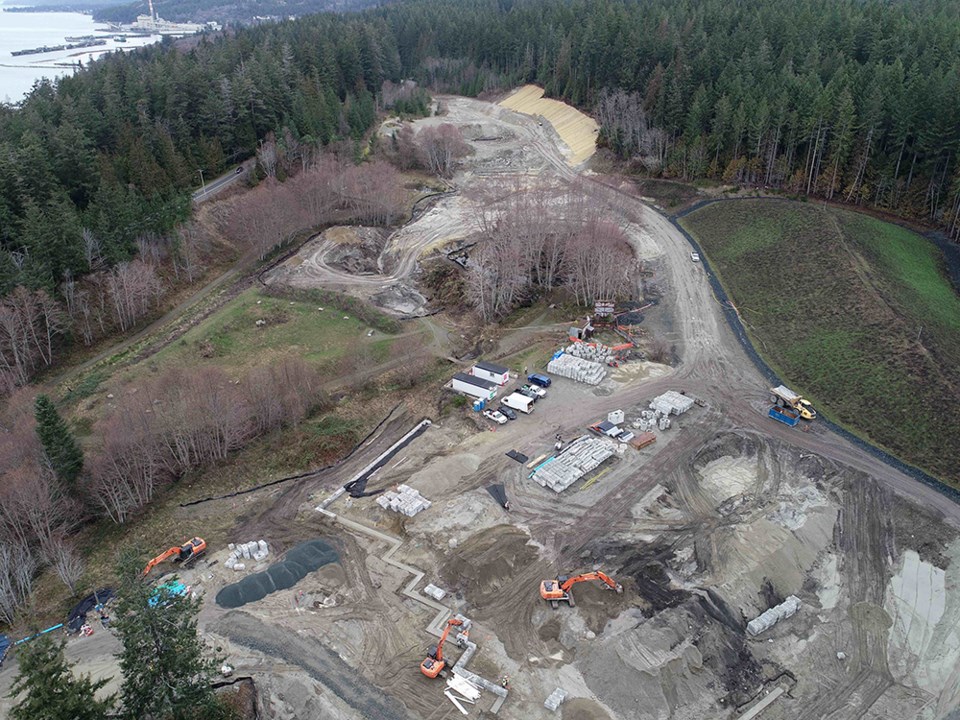qathet Regional District (qRD) has published a history of the Marine Avenue waste disposal site in Westview, which provides readers a colourful and illustrated view of municipal solid waste processing, past and present.
Let’s Talk Trash team member Tai Uhlmann, one of the authors, said the report was generated from a collective need to publish a comprehensive history of the multi-year solid waste projects.
“For the public and the regional board, it’s important to have a concise overview,” said Uhlmann. “We chose to create a visual report with a lot of photos and documentation from the site, making it user-friendly and understandable.
“It goes step-by-step from how the Marine Avenue site started to how we got to where we are today. It features, along the way, all the decision making and input that made our resource-recovery centre and waste-transfer station project possible.”
Uhlmann said the centre and station now being constructed is located on the Marine Avenue grounds of City of Powell River’s old incinerator site, which operated from the 1970s until the early 1990s.
“That was ordered closed by the ministry of environment,” said Uhlmann. “The city held the permit for the old incinerator site. After the incinerator closed the site was turned into a waste-transfer station and it was also eventually closed.”
Uhlmann said that is when the solid waste management switched to private industry and the waste-transfer station went to Augusta Recycling, which was the successful bidder for the request for proposals that was issued.
Uhlmann said qRD has a significant role to play because it is the responsibility of regional districts to create solid waste management plans and manage solid waste. In 2017, the qRD solid waste management plan was redrawn and approved by the province. Uhlmann said it offered a collaborative approach between the city and qRD, with the regional district offering to help with the Marine Avenue closure plan process.
“Within that process the regional district identified an opportunity to write a $6 million grant that was awarded and to add all the benefits of a resource-recovery centre at that site,” said Uhlmann. “That’s not what was mandated, but it was an opportunity that was seen, and the regional district stepped up to do that.”
Uhlmann said the $6-million grant was allocated for the closure of the old incinerator site and the build-out of the resource-recovery centre, which is the recycling portion of the solid waste disposal site. In terms of waste transfer, where the garbage is collected for transportation to Washington State, it was decided in the 2017 solid waste management plan to bring it back into the governmental/public domain at the Marine Avenue site rather than having it operate as a private corporate service at Augusta.
Uhlmann said there have been grants written to help fund the station at the site. Two were unsuccessful and the regional district is waiting to hear the results of the third application.
“Regional district staff have been looking for every opportunity to bring down the cost of this project,” said Uhlmann. “It has been qRD staff’s priority.”
Uhlmann said site closure has been completed. For the design of the site, a request for proposals was put out by the qRD. The successful proponent was Harold Engineering; qRD has been working with the company for site design.
Innovations result in savings
A construction management team called MKM Projects has been retained, and is the prime contractor, according to Uhlmann. Tenders have gone out for the main structures to be built at the site, she said.
There has already been innovation. For closure of the enclosed landfill portion, the regional district chose natural asset solutions for the stormwater runoff, saving around $800,000 over engineered solutions. The project won an award from the Union of British Columbia Municipalities.
Uhlmann said by repurposing and reusing materials onsite, further savings have been made.
“Wherever we find an opportunity to reduce costs, and greenhouse gas emissions, we’ve gone with those options,” said Uhlmann. “We want to innovate however we can.”
Let’s Talk Trash and regional district staff have worked hard to research what works and what doesn’t in other solid waste facilities in BC, she added.
Uhlmann said something that stands out in the design for qRD is a focus on diversion.
“We’ll be incorporating diversion for things like reusable construction demolition materials,” she said. “We’ll have a covered area where we can safely put aside materials to divert them.
“We are exporting our thrown-out materials 770 kilometres, one-way, so as much as we can reduce it, it’s a win.”
The new waste-transfer facility will also be designed to divert compostable organic material for local processing, further reducing the amount of waste being transported. Uhlmann said organics make up about 40 per cent of garbage content.
“You’ll have the opportunity to divert clean wood, yard and garden material, metal and other materials,” she added. “You’ll have everything in one location. It will make it easier if people are separating their waste to spend less for disposal.
“That’s the goal of the site. We want to reduce costs and make it convenient. When you enter the site there will be a free side, so if you are dropping off certain materials, you don’t have to go over the scale to the waste-transfer site. Once you cross the scale, that’s where fees would apply.”
Construction of the resource-recovery centre and waste-transfer station is set to begin in 2023, and completion should be in 2024, said Uhlmann. The hope is to have the facility operational by summer of 2024.
Uhlmann said the objective is to see waste as a resource.
“If we look at things differently, we will see all these different opportunities,” said Uhlmann. “We’re working towards zero waste.”
To learn more about the site reclamation and the development of the centre, go to qathet.ca/current_project/resource-recovery-centre.



.jpg;w=120;h=80;mode=crop)